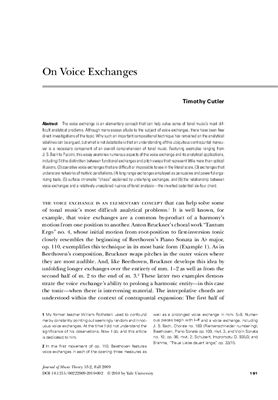Joual of Music Theory Fall 2009 53(2): 191-226
Abstract The voice exchange is an elementary concept that can help solve some of tonal music’s most difficult analytical problems. Although many essays allude to the subject of voice exchanges, there have been few
direct investigations of the topic. Why such an important compositional technique has remained on the analytical
sidelines can be argued, but what is not debatable is that an understanding of this ubiquitous contrapuntal maneuver is a necessary component of an overall comprehension of tonal music. Featuring examples ranging from
J. S. Bach to Puccini, this essay examines numerous aspects of the voice exchange and its analytical applications,
including (1) the distinction between functional exchanges and pitch swaps that represent little more than optical
illusions, (2) operative voice exchanges that are difficult or impossible to see in the literal score, (3) exchanges that
underscore networks of motivic parallelisms, (4) long-range exchanges employed as persuasive and powerful organizing tools, (5) surface chromatic chaos explained by underlying exchanges, and (6) the relationship between
voice exchanges and a relatively unexplored nuance of tonal analysis—the inverted cadential six-four chord.
Abstract The voice exchange is an elementary concept that can help solve some of tonal music’s most difficult analytical problems. Although many essays allude to the subject of voice exchanges, there have been few
direct investigations of the topic. Why such an important compositional technique has remained on the analytical
sidelines can be argued, but what is not debatable is that an understanding of this ubiquitous contrapuntal maneuver is a necessary component of an overall comprehension of tonal music. Featuring examples ranging from
J. S. Bach to Puccini, this essay examines numerous aspects of the voice exchange and its analytical applications,
including (1) the distinction between functional exchanges and pitch swaps that represent little more than optical
illusions, (2) operative voice exchanges that are difficult or impossible to see in the literal score, (3) exchanges that
underscore networks of motivic parallelisms, (4) long-range exchanges employed as persuasive and powerful organizing tools, (5) surface chromatic chaos explained by underlying exchanges, and (6) the relationship between
voice exchanges and a relatively unexplored nuance of tonal analysis—the inverted cadential six-four chord.

